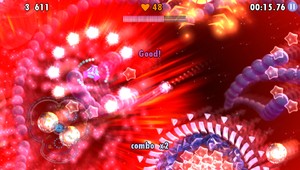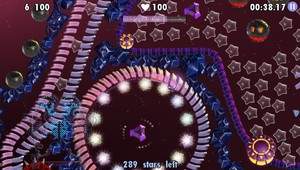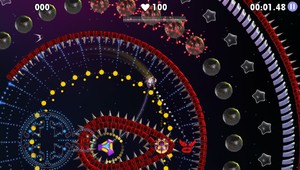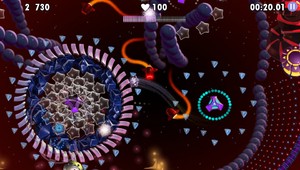
StarDrone was one of last year’s better PlayStation Network titles. The game’s furious blend of disparate game mechanics culminated in one of the most memorable puzzle titles of 2011, earning it a convincing 7/10 score in our StarDrone review.
Today’s European PlayStation Store update sees the pinball-hybrid find a new home on the PlayStation Vita, as StarDrone Extreme iterates upon last year’s PS3 release and sprinkles new features such as cross-platform compatibility and touch screen controls on top.
To celebrate the game's launch, we sat down with BeatShapers’ Alexey Menshikov and Orb Games’ Andriy Sharanevych to find out exactly how the gorgeous intergalactic puzzler’s been slimmed down to pocket size.
Don't forget to check out our exclusive StarDrone Extreme trailers and stay tuned to the Push Square Twitter for details of how you could win the game.
Push Square: Hi guys, thanks so much for dropping by to chat to us about StarDrone Extreme. We were big fans of the PlayStation 3 release, but for those that didn’t get a chance to check it out could you tell us a little bit about your game?
Andriy Sharanevych: Sure. In StarDrone Extreme, you pilot an always-in-motion spaceship through diverse cosmic environments in order to achieve all 60 of the game’s goals. Goals range from safely reaching the end of a level to destroying all of the enemies, collecting specific items and more.

What’s unique about this game is the way you control your spaceship and how you actually play. Each level starts by aiming and shooting yourself out of a cannon. Your spaceship stays in motion from this point onwards, and it's your job to attach to nearby gravity beacons to navigate its flight path.
The game controls are very intuitive and clear – you just select the desired beacon with your finger, and then release it; the game does everything else. This core mechanic allowed us to bring together the best elements of shoot ‘em ups, pinball and more. It also has great visuals, of course.
PS: Of course! Can you tell us a little bit about the process of porting StarDrone to Sony’s shiny new handheld? When did you make the decision to bring the game to PS Vita?
Alexey Menshikov: I was invited to visit Sony Computer Entertainment Europe’s office in London where they showed us a Vita and talked a little bit about its features and expectations.
PS: And were you excited about what you saw?
AM: Yes, I totally was. First of all, it was great opportunity to be involved with another launch like PlayStation Minis, and secondly, the device’s hardware and possibilities seemed really amazing. At the presentation, they mentioned that it would feature cross compatibility, and, seeing as we’d already finished the PS3 version of StarDrone, it was an easy decision for us to bring the title to Vita.
PS: Just like that. So how exactly does the Vita version of StarDrone differ from its home console counterpart?
AS: The main difference is definitely the control scheme. On PlayStation 3, you attach to beacons by pointing at them with your PlayStation Move motion controller – it’s a little bit like a laser pointer. That works great and offers very precise and intuitive control, but on Vita it works even better – mostly due to the touch controls. You literally hold the game field in your hand and tap on it to interact. That’s it – it’s very straightforward. And you can also switch to using the rear touch panel if you prefer.

PS: Are you using the rear touch controls in any other way?
AS: We actually have two modes for rear touch panel controls. As I mentioned, one is similar to using the front touch screen, while the other uses the whole rear touch panel as a single button. In that instance, when you tap somewhere on the back panel, the game executes a special prediction algorithm to automatically select the beacon most likely to be targeted by you. Another big difference is the new content – we’ve actually created a bunch of brand-new exclusive levels for the Vita., and have also revamped older levels according to players’ feedback, and tidied up the user interface and visuals.
PS: Anything else?
AS: Of course. Other cool new features include an adjustable skill setting, so the game does not punish you when you make a mistake, and the ability to skip the current level when you get stuck. There are lots of other minor improvements too.
PS: Sounds like you’ve been busy. Speaking of some of the new inclusions, was it challenging coming up with ways to use some of the Vita’s more exotic input functions?
AS: No, not challenging at all. It was obvious from the beginning that we were going to use touch for the controls. The game translated perfectly to utilise the new input method. The rear touch panel also looked promising, but we were not sure how it would actually feel until we got the hardware and implemented our ideas. Suddenly, all of our questions got answered.

PS: StarDrone Extreme is one of the first Vita titles to take advantage of cross-platform play – was that planned from the beginning?
AM: Yes and no: we made the decision to bring StarDrone to Vita based on the idea of cross compatibility, but obviously a year ago we didn’t know how that would work. Originally we pitched a cross platform network feature similar to OpenFeint. The general idea was to allow players to set high scores and then challenge their PSN friends. Players would try to beat each other’s scores across both platforms, so the rivalry would go back and forth. Unfortunately this proved too hard to pitch and even harder to develop without significant input from Sony, so we postponed the idea.
PS: That’s a shame. So what did you eventually come up with?
AM: Well, we started to look at how else we could connect our players in addition to shared scoreboards, and decided upon a cloud save feature. This allows players to exchange game progress between platforms and even trophies too. The cross play feature itself is available through a day zero patch on the PS3 version.
PS: Do you have any plans to develop any more titles for the Vita beyond StarDrone Extreme?
AM: Yes, we actually have three more games in production for the Vita right now, including a multiplayer puzzle game, a cross-platform zombie survival game and a port of a popular platformer with exclusive Vita content.

We also have four new Minis in the works which are set to be released within the next four months. In fact, we’re actually going to announce one of the games in the next couple of weeks, so stay tuned to our Twitter and Facebook accounts for that – we have very exciting things to show.
PS: Fantastic news. Just to finish, it’s fair to say that you’ve been pretty big advocates of the PlayStation platform over the past few years. As a small studio, what’s the advantage of developing for Sony’s platform over, say, the iOS format?
AM: There are a number of technical advantages – the hardware is much more powerful to start with. We know our audience and are comfortable submitting and promoting games on PSN. We also have a great rapport with Sony who helps us with any issues we encounter and sees us as one of next generation of developers. We feel quite comfortable with them. However, the iOS market is very big and is growing fast so we cannot avoid that platform either – we’ll definitely have some games releasing there in the future too.
PS: Thanks so much for taking a break from your hectic schedule in order to chat with us, and we wish you all the best with the launch.

Comments 2
Really enjoyed StarDrone with Move, so I'm looking forward to taking this one for a spin, erm... touch.
What has been done with the PS3 version of the game in terms of update improvements? Also, is it now Stardrone Extreme, or still Stardrone but able to share scores with the enhanced Vita version?
Leave A Comment
Hold on there, you need to login to post a comment...